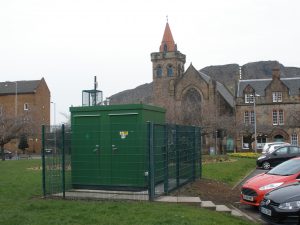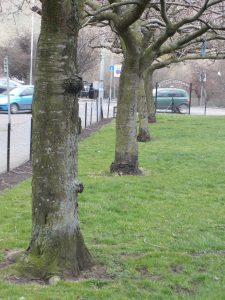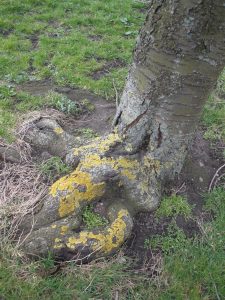The journey begins. 8am. I’ve just cycled north to south through the bustling traffic heavy centre of Edinburgh. I arrive, lock up my bike, pull out a clip board, hand lens, compass, tape measure and field guide and survey the scene…
Ever noticed the rather odd looking green or grey container – box – shed like structures that sit gently whirring on the pavement at the side of roads or discretely placed in small urban parks? The chances are you haven’t. Or if you have you will have, like me vaguely wondered about them and then gone on your way.
So what exactly are these strange sometimes rather Dr Who looking contraptions (see Gorgie Road Blog) and why am I now taking more than a passing interest in them?
Well as part of my TCV Natural Talent Traineeship based at the Royal Botanic Garden Edinburgh I have spent the last few weeks gaining knowledge in lichen taxonomy and gathering the available online data (see Air Quality in Scotland) collected by these machines. I can safely divulge that these are highly sophisticated pieces of equipment with the very un-snappy title of ‘Air Quality Monitoring Stations’. The one pictured (placed in Deconess Gardens – St Leonards) is one of 91 automatic monitoring sites placed across Scotland.
These monitoring stations provide information on the state of local air quality by measuring potentially harmful pollutants such as Nitrogen dioxide, Nitric oxides, Ozone, Sulphur dioxide and Particulate matter (small solid particles and liquid droplets found in the air, such as dust, dirt, soot, or smoke).
It is long been documented that the humble lichen is highly sensitive to various air pollutants and I’m here to see just how air pollution in Edinburgh is affecting lichens populations and species on our trees within the city. The aim being to find Edinburgh specific lichen indicators of local air quality.
I try to look inconspicuous as I scope out the nearest four lichen laden trees in the vicinity of the monitoring station, take my measurements and identify as many lichens as I can find – from knee height to head height on the tree trunks…. But the combination of my fluorescent jacket and my rather odd behaviour which includes measuring tree girths – an activity which could understandably be mistaken for tree hugging, and standing still for long periods of time with my face VERY close to the tree trunk…. gets me some inquisitive, odd side-glances from passers-by.
I am also definite spectator sport for the customers sitting drinking coffee at the cafe which looks out onto the garden. No-one has yet dared asked me what exactly I am doing.
A heavily used public garden, the trees here display the tell-tale signs of nutrient enrichment from passing dogs (see the tide-lines on the trees where there is an very clear change in lichen flora)
At this early stage in my traineeship this site, with quite a broad range of lichen, is a wonderful challenge for newly aquired taxonomic skills – fantastic to find some lichens I’ve not seen before.
I look forward to my onward lichen surveying journey around Edinburgh – it’s a great way to get to know and spend time in parts of the city I may otherwise have never explored.
See if you too, like me now start to spot these monitoring sites as you make your way around the city!
Part of the Edinburgh Living Landscape initiative & the TCV Natural Talent scheme



